Top Rankings
Michigan Great Lakes Virtual Academy School District ranks among the top 20% of public school district in Michigan for:
Category
Attribute
Diversity
Most diverse schools (Top 1%)
Community Size
Largest student body (number of students) (Top 1%)
For the 2025 school year, there is 1 public school serving 3,444 students in Michigan Great Lakes Virtual Academy School District. This district's average testing ranking is 2/10, which is in the bottom 50% of public schools in Michigan.
Public School in Michigan Great Lakes Virtual Academy School District have an average math proficiency score of 10% (versus the Michigan public school average of 34%), and reading proficiency score of 27% (versus the 46% statewide average).
Minority enrollment is 46% of the student body (majority Black), which is more than the Michigan public school average of 37% (majority Black).
Overview
This School District
This State (MI)
# Schools
1 School
3,509 Schools
# Students
3,444 Students
1,376,331 Students
# Teachers
162 Teachers
82,379 Teachers
Student : Teacher Ratio
21:1
21:1
District Rank
Michigan Great Lakes Virtual Academy School District, which is ranked within the bottom 50% of all 851 school districts in Michigan (based off of combined math and reading proficiency testing data) for the 2021-2022 school year.
The school district's graduation rate of 53% has increased from 29% over five school years.
Overall District Rank
#720 out of 866 school districts
(Bottom 50%)
(Bottom 50%)
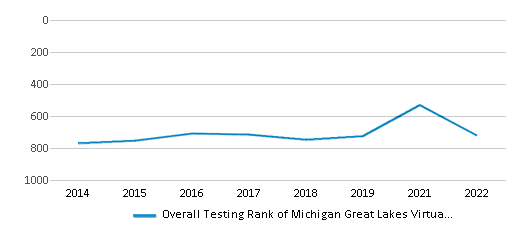
Math Test Scores (% Proficient)
10%
34%
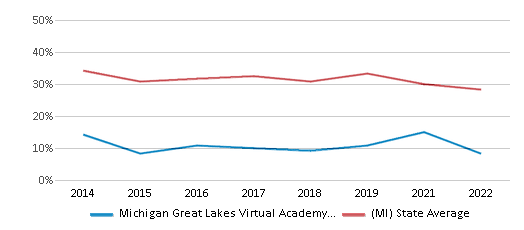
Reading/Language Arts Test Scores (% Proficient)
27%
45%
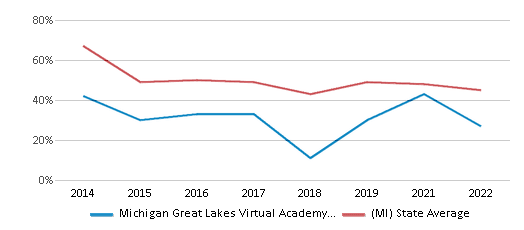
Science Test Scores (% Proficient)
24%
38%
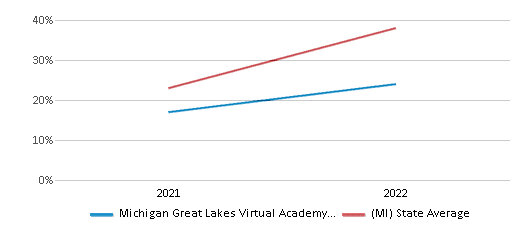
Graduation Rate
53%
81%
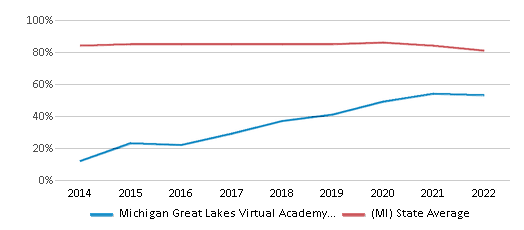
Students by Ethnicity:
Diversity Score
0.63
0.56
# American Indian Students
14 Students
8,574 Students
% American Indian Students
1%
1%
# Asian Students
45 Students
50,770 Students
% Asian Students
1%
4%
# Hispanic Students
323 Students
125,678 Students
% Hispanic Students
10%
9%
# Black Students
839 Students
244,434 Students
% Black Students
24%
18%
# White Students
1,874 Students
871,645 Students
% White Students
55%
63%
# Hawaiian Students
2 Students
1,208 Students
% Hawaiian Students
n/a
n/a
# Two or more races Students
292 Students
73,219 Students
% of Two or more races Students
9%
5%
Students by Grade:
# Students in PK Grade:
-
-
# Students in K Grade:
159
110,461
# Students in 1st Grade:
176
100,790
# Students in 2nd Grade:
180
102,777
# Students in 3rd Grade:
176
100,401
# Students in 4th Grade:
180
101,847
# Students in 5th Grade:
173
101,136
# Students in 6th Grade:
249
102,120
# Students in 7th Grade:
285
103,285
# Students in 8th Grade:
340
102,692
# Students in 9th Grade:
375
114,669
# Students in 10th Grade:
361
112,993
# Students in 11th Grade:
396
109,871
# Students in 12th Grade:
394
109,317
# Ungraded Students:
-
3,972
District Revenue and Spending
The revenue/student of $9,735 in this school district is less than the state median of $18,510. The school district revenue/student has stayed relatively flat over four school years.
The school district's spending/student of $8,868 is less than the state median of $17,693. The school district spending/student has stayed relatively flat over four school years.
Total Revenue
$34 MM
$25,476 MM

Spending
$31 MM
$24,351 MM
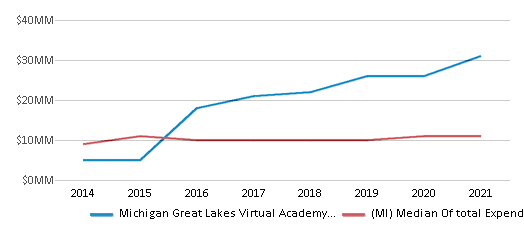
Revenue / Student
$9,735
$18,510
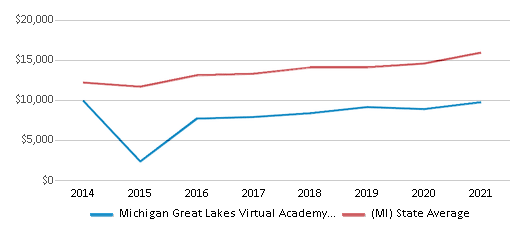
Spending / Student
$8,868
$17,693
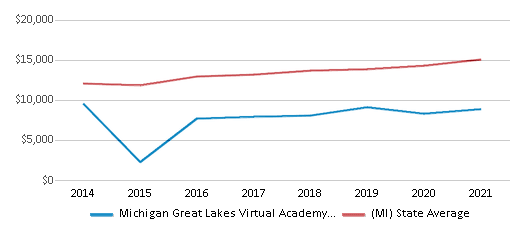
Best Michigan Great Lakes Virtual Academy School District Public Schools (2025)
School
(Math and Reading Proficiency)
(Math and Reading Proficiency)
Location
Grades
Students
Rank: #11.
Michigan Great Lakes Virtual Academy
Charter School
(Math: 10% | Reading: 27%)
Rank:
Rank:
2/
Bottom 50%10
1309 Madison Rd
Manistee, MI 49660
(231) 794-5999
Manistee, MI 49660
(231) 794-5999
Grades: PK-12
| 3,444 students
Frequently Asked Questions
How many schools belong to Michigan Great Lakes Virtual Academy School District?
Michigan Great Lakes Virtual Academy School District manages 1 public schools serving 3,444 students.
What is the rank of Michigan Great Lakes Virtual Academy School District?
Michigan Great Lakes Virtual Academy School District is ranked #713 out of 851 school districts in Michigan (bottom 50%) based off of combined math and reading proficiency testing data for the 2021-2022 school year. This district ranks in the top 20% of Michigan school districts for: Most diverse schools (Top 1%) and Largest student body (number of students) (Top 1%)
What is the racial composition of students in Michigan Great Lakes Virtual Academy School District?
55% of Michigan Great Lakes Virtual Academy School District students are White, 24% of students are Black, 10% of students are Hispanic, 9% of students are Two or more races, 1% of students are American Indian, and 1% of students are Asian.
What is the student/teacher ratio of Michigan Great Lakes Virtual Academy School District?
Michigan Great Lakes Virtual Academy School District has a student/teacher ratio of 21:1, which is higher than the Michigan state average of 17:1.
What is Michigan Great Lakes Virtual Academy School District's spending/student ratio?
The school district's spending/student of $8,868 is less than the state median of $17,693. The school district spending/student has stayed relatively flat over four school years.
Recent Articles

Year-Round Or Traditional Schedule?
Which is more appropriate for your child? A year-round attendance schedule or traditional schedule? We look at the pros and cons.

Why You Should Encourage Your Child to Join a Sports Team
Participating in team sports has a great many benefits for children, there is no doubt. In this article you will learn what those benefits are.

White Students are Now the Minority in U.S. Public Schools
Increasing birth rates among immigrant families from Asia and Central and South America, combined with lower birth rates among white families, means that for the first time in history, public school students in the United States are majority-minority. This shift in demographics poses difficulties for schools as they work to accommodate children of varying language abilities and socio-economic backgrounds.





